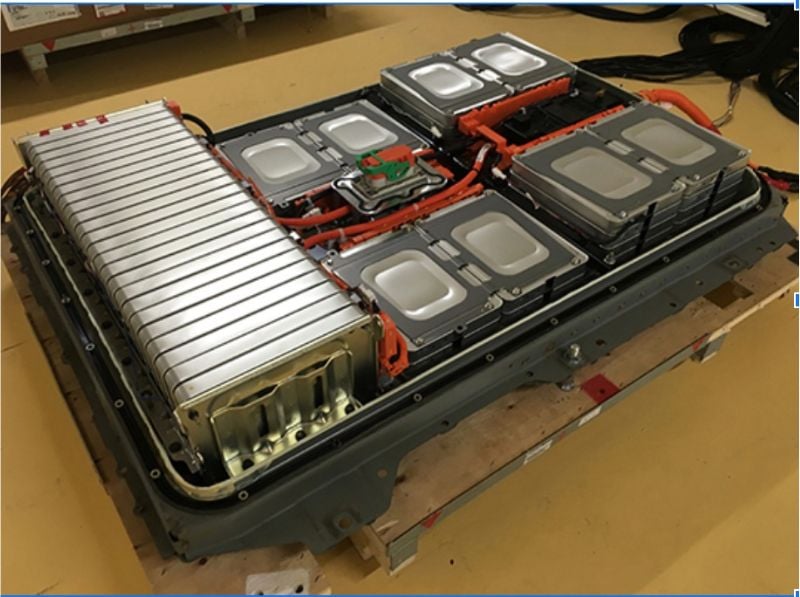Following the Life of a Nissan Leaf Battery
Following the life—and afterlife—of an EV battery puts a pervasive industry misperception to rest.
In the world of electric vehicles (EVs), there is a persistent myth: Lithium-ion traction batteries used for energy storage cannot be recycled, and landfills will soon be inundated with hazardous spent batteries.
The Leaf lithium-ion battery. Image used courtesy of Nissan Motor Corporation
This couldn't be further from the truth. In reality, these lithium-ion batteries are poised to be recycled on a monumental scale, thanks to the valuable materials they contain, which can be used to create new batteries. But before they reach the end of their road, the batteries from EVs hold untapped potential to power a multitude of other applications.
That's why, several months before the very first Leaf hit the market in December 2010, Nissan joined forces with Sumitomo Corp. to establish 4R Energy Corp. 4R Energy pioneered the technology and infrastructure necessary to refabricate, recycle, resell, and reuse batteries from the Nissan Leaf, not for their scrap value, but to electrify other aspects of our lives.
The Leaf Battery’s First Life
The Leaf’s standard 40 kWh battery delivers up to 149 EPA-estimated miles on a single charge, while the available 60 kWh battery on the Nissan Leaf SV Plus provides up to 212 miles of EPA-estimated range per charge. The lithium-ion battery in the LEAF is covered by a 96-month (eight-year) or 100,000-mile warranty (whichever comes first), and in addition, the battery is warranted against capacity loss over the eight years.
A recycled lithium-ion battery from a Nissan Leaf powers a railway crossing in Japan. Image used courtesy of Nissan Stories
It turns out that lithium-ion batteries are quite robust, and the company has seen some vehicles with 10 years or more of service on the original battery. Nissan has sold more than 650,000 Leafs worldwide since its launch.
Even as a lithium-ion battery reaches the end of its first life powering a vehicle, it still has at least 80 percent of capacity available. While this isn’t enough to provide acceptable EV performance, the batteries are still powerful enough for industrial machinery such as forklifts and large stationary energy storage systems.
These batteries can be deployed in homes or commercial facilities, capturing surplus solar-generated electricity during the day, and providing power during the night. Nissan is repurposing them at the 4R factory.
The 4R Reycling Transformation
When an aging EV battery arrives at the 4R factory, it undergoes a thorough grading process. Some components emerge as good as new, earning an "A" grade, and find their way into new high-performance battery units for fresh EVs.
Those receiving a "B" grade still pack enough power to support most non-EV industrial applications like grid storage. Even the components of a "C" grade battery have their place, providing backup power when the electric grid falters, ensuring essentials like grocery store refrigerators and lights stay operational during outages. The engineers at 4R Energy estimate that these rehabilitated batteries can enjoy a second life of about 10 to 15 years, significantly extending the usefulness of EV batteries while shrinking their overall carbon footprint.
Nissan gives EV batteries a second life. Image used courtesy of Nissan Motor Corporation
Some of 4R Energy's second-life battery applications include:
-
Industrial machinery: Batteries can be used to power forklifts, robots, and other industrial machinery. This can help to reduce the machine’s emissions, which can be significant.
-
Large stationary energy storage systems: Wind and solar power plants can use batteries to store energy. This can help to stabilize the grid and make it more reliable.
-
Backup power: Batteries can be used to provide backup power during grid outages. This can help to keep essential services running, such as hospitals and grocery stores.
-
Home energy storage: Batteries can be used to store solar energy for use at night or during peak demand times, helping homeowners reduce their electricity bills.
EV Battery Afterlife
Nissan is using some of its old Leaf batteries in a portable power source that it has developed with electronics specialist JVCKenwood Corp. and 4R Energy Corp. While the Leaf has 48 battery modules, the 14.4-kilogram (32-pound) power source uses just two of the EV’s modules to provide power. The device sells for 170,500 yen ($1,170) in Japan but is not yet available in overseas markets.
A decade after launching the first all-electric Nissan Leaf, the company and its partners are giving EV batteries a second life. Moving forward, 4R Energy Corp. is gearing up to provide the same "4R" support—recycle, refabricate, reuse, resell—for the next generation of electric vehicles from Nissan that will be launched in the coming decade, starting with the new all-electric Ariya.










While it may be possible to recycle batteries I can almost guarantee you the typical American person who has small batteries such as the ones in their power tools that they’re going to use when they’re bad are going to have been landfill that’s the plain and simple truth larger batteries as they become more abundant and people don’t do with them the same things going to happen because no one wants to spend the time or effort to actually recycle them or know where to take them